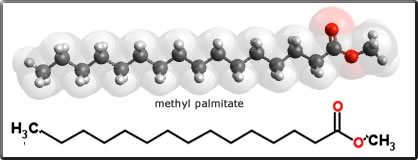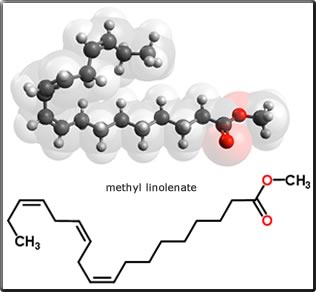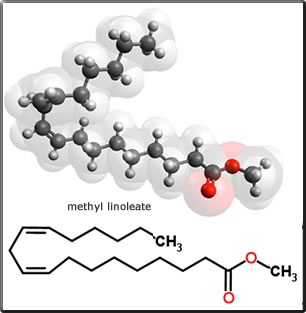Genetics 2E
Genetics and Pheromones - Honey bee communicaton within the Colony
The behaviour of the bees within the colony is governed by its genetic makeup and the presence of pheromones.
The honey bee has one of the most complex pheromonal communication systems found in nature, possessing 15 known glands that produce an array of compounds.
These chemical messengers secreted by a queen, drone, worker bee, brood, and laying worker bee elicit a response in other bees in the colony. They are produced as a volatile or non-volatile liquid and transmitted by direct contact. These chemical messages are received by the bee's antenna and other body parts.
The bee pheromones can be grouped into
releaser pheromones which temporarily affect the recipient's behaviour and trigger an immediate response, and
primer pheromones which have relatively slow and long-term effect on the physiology and behaviour of the recipient.
The pheromones may either be single chemicals or a complex mixture.
Their use in the interactions between the bees can be summarized as:
the queen and drones; the queen and workers; between workers; and workers and brood.
The behaviour of the bees within the colony is governed by its genetic makeup and the presence of pheromones.
The honey bee has one of the most complex pheromonal communication systems found in nature, possessing 15 known glands that produce an array of compounds.
These chemical messengers secreted by a queen, drone, worker bee, brood, and laying worker bee elicit a response in other bees in the colony. They are produced as a volatile or non-volatile liquid and transmitted by direct contact. These chemical messages are received by the bee's antenna and other body parts.
The bee pheromones can be grouped into
releaser pheromones which temporarily affect the recipient's behaviour and trigger an immediate response, and
primer pheromones which have relatively slow and long-term effect on the physiology and behaviour of the recipient.
The pheromones may either be single chemicals or a complex mixture.
Their use in the interactions between the bees can be summarized as:
the queen and drones; the queen and workers; between workers; and workers and brood.
Queen retinue pheromone (QRP)
The following compounds have also been identified, of which only coniferol is found in the mandibular glands. The combination of the 5 QMP compounds and the 4 compounds below is called the Queen Retinue Pheromone (QRP). These nine compounds are important for the retinue attraction of worker bees around their queen.
methyl-(Z)-octadec-9-enoate (methyl oleate)
(E)-3-(4-hydroxy-3-methoxyphenyl)-prop-2-en-1-ol (coniferol)
hexadecan-1-ol (cetyl alcohol)
(Z9,Z12,Z15)-octadeca-9,12,15-trienoic acid (linolenic acid)
The following compounds have also been identified, of which only coniferol is found in the mandibular glands. The combination of the 5 QMP compounds and the 4 compounds below is called the Queen Retinue Pheromone (QRP). These nine compounds are important for the retinue attraction of worker bees around their queen.
methyl-(Z)-octadec-9-enoate (methyl oleate)
(E)-3-(4-hydroxy-3-methoxyphenyl)-prop-2-en-1-ol (coniferol)
hexadecan-1-ol (cetyl alcohol)
(Z9,Z12,Z15)-octadeca-9,12,15-trienoic acid (linolenic acid)
Queen mandibular pheromone (QMP)
QMP, emitted by the queen, is one of the most important sets of pheromones in the bee hive. It affects social behaviour, maintenance of the hive, swarming, mating behaviour, and inhibition of ovary development in worker bees. The effects can be short and/or long term. Some of the chemicals found in QMP are carboxylic acids and aromatic compounds which are relatively non-volatile. The following compounds have been shown to be important in retinue attraction of workers to their queen and other effects.
QMP, emitted by the queen, is one of the most important sets of pheromones in the bee hive. It affects social behaviour, maintenance of the hive, swarming, mating behaviour, and inhibition of ovary development in worker bees. The effects can be short and/or long term. Some of the chemicals found in QMP are carboxylic acids and aromatic compounds which are relatively non-volatile. The following compounds have been shown to be important in retinue attraction of workers to their queen and other effects.
Pheromones used in the Interaction of the Queen and Workers
-decenoic acid.jpg)
9-oxo-2-(E)-decenoic acid (9-ODA) – inhibits queen rearing as well as ovarian development in worker bees; strong sexual attractant for drones when on a nuptial flight; critical to worker recognition of the presence of a queen in the hive
Two biosynthetic precursors of 9-ODA are
(2E,9R)-(-)-9-hydroxy-2-decenoic acid (9-HDA) and
(2E,9S)-(+)-9-hydroxy-2-decenoic acid (9-HDA) are enantiomers (mirror images) and biosynthetic precursors of 9-ODA
Methyl-4-hydroxybenzoate (HOB)
4-hydroxy-3-methoxy-phenylethanol (HVA)
These 5 chemicals are found in a ratio of 118:50:22:10:1
Two biosynthetic precursors of 9-ODA are
(2E,9R)-(-)-9-hydroxy-2-decenoic acid (9-HDA) and
(2E,9S)-(+)-9-hydroxy-2-decenoic acid (9-HDA) are enantiomers (mirror images) and biosynthetic precursors of 9-ODA
Methyl-4-hydroxybenzoate (HOB)
4-hydroxy-3-methoxy-phenylethanol (HVA)
These 5 chemicals are found in a ratio of 118:50:22:10:1
Nasanov pheromone
is released by worker bees to orient returning foragers back to the colony. Bees can be seen on the alighting board with their abdomens raised, the Nasanov gland exposed and fanning vigorously. These bees are also seen when a swarm finds a new home. The pheromone is also released on flowers so other bees know which flowers have been visited.
Many of the components of the Nasanov pheromone are biochemically related (Slessor et al., 2005). In this mixture were identified nerol (Z)-3,7-dimethyl-2,6-octadien-1-ol), and geraniol (E)-3,7-dimethyl-2,6-octadien-1-ol);
(E) and (Z)-citral (E/Z)-3,7-dimethyl-2,6-octadienal);
nerolic acid ((Z)-3,7-dimethyl-2,6-octadienoic acid), and geranic acid (E)-3,7-dimethyl-2,6-octadienoic acid) and
(E,E)-Farnesol - (2E,6E)-3,7,11-trimethyldodeca-2,6,10-trien-1-ol.
These terpene derivatives contribute to the characteristic odour of several plant species (for example lemongrass).
is released by worker bees to orient returning foragers back to the colony. Bees can be seen on the alighting board with their abdomens raised, the Nasanov gland exposed and fanning vigorously. These bees are also seen when a swarm finds a new home. The pheromone is also released on flowers so other bees know which flowers have been visited.
Many of the components of the Nasanov pheromone are biochemically related (Slessor et al., 2005). In this mixture were identified nerol (Z)-3,7-dimethyl-2,6-octadien-1-ol), and geraniol (E)-3,7-dimethyl-2,6-octadien-1-ol);
(E) and (Z)-citral (E/Z)-3,7-dimethyl-2,6-octadienal);
nerolic acid ((Z)-3,7-dimethyl-2,6-octadienoic acid), and geranic acid (E)-3,7-dimethyl-2,6-octadienoic acid) and
(E,E)-Farnesol - (2E,6E)-3,7,11-trimethyldodeca-2,6,10-trien-1-ol.
These terpene derivatives contribute to the characteristic odour of several plant species (for example lemongrass).
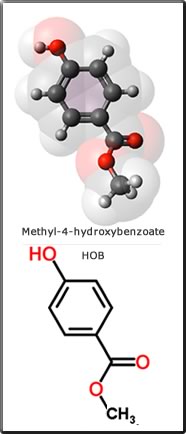

A synthetically produced Nasanov pheromone can be used to attract a honey bee swarm to a lure hive.
Synthetically produced Nasanov consists of citral and geraniol in a 2:1 ratio.
Oil of lemongrass can also be used.
Synthetically produced Nasanov consists of citral and geraniol in a 2:1 ratio.
Oil of lemongrass can also be used.
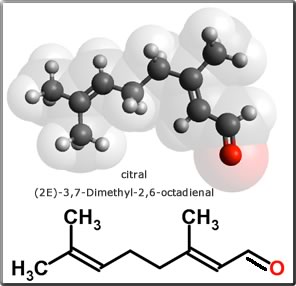
Alarm pheromones
are produced by honey bee workers in the mandibular gland and through the Koschevnikov gland, near the sting shaft. Over 40 chemical compounds have been identified, including isopentyl acetate (IPA), butyl acetate, 1-hexanol, n-butanol, 1-octanol, hexyl acetate, octyl acetate, n-pentyl acetate and 2-nonanol.
These chemical compounds have low molecular weights, are highly volatile, and appear to be the least specific of all pheromones. Alarm pheromones are released when a bee stings. These pheromones then attract other bees to the location and cause these bees to behave defensively, i.e. sting or charge. Smoke can be used to mask the bees' alarm pheromone.
(11Z)-11-icosen-1-ol has also been identified as another effective alarm pheromone for inducing sting behaviour. This pheromone prolongs the activity of the more volatile iso-pentyl acetate by slowing down the evaporation of the latter.
are produced by honey bee workers in the mandibular gland and through the Koschevnikov gland, near the sting shaft. Over 40 chemical compounds have been identified, including isopentyl acetate (IPA), butyl acetate, 1-hexanol, n-butanol, 1-octanol, hexyl acetate, octyl acetate, n-pentyl acetate and 2-nonanol.
These chemical compounds have low molecular weights, are highly volatile, and appear to be the least specific of all pheromones. Alarm pheromones are released when a bee stings. These pheromones then attract other bees to the location and cause these bees to behave defensively, i.e. sting or charge. Smoke can be used to mask the bees' alarm pheromone.
(11Z)-11-icosen-1-ol has also been identified as another effective alarm pheromone for inducing sting behaviour. This pheromone prolongs the activity of the more volatile iso-pentyl acetate by slowing down the evaporation of the latter.

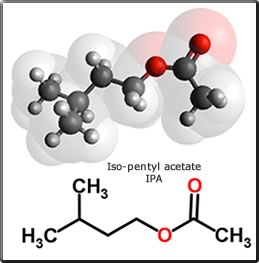
Some information on this page was sourced from the wikipedia website.
The chemical structures were produced using a combination of: Jmol : ChemSpider and Avogadro.
The chemical structures were produced using a combination of: Jmol : ChemSpider and Avogadro.
QMP is transferred through the hive as a unit. After being secreted onto the body of the queen, it is removed by the workers around the queen especially through the transfer of food. Other workers acquire QMP through direct contact with the retinue bees especially by grooming. Other worker can acquire QMP through the footprints on the comb left by the queen or workers already possessing the pheromone.
QMP has been found to slow the transition of nurse bees to foragers. And to regulate the timing of swarming. QMP normally inhibits queen rearing but as the colony grows the amount of QMP reaching the workers decreases due both to a dilution effect and because of the restricted movement of the workers. These are then released from the inhibition which QMP imposes on them and they start to made queen cells in readiness for swarming.
9-ODA in particular acts as a sex pheromone in attracting drones to the queen when on her mating flight.
QMP has been found to slow the transition of nurse bees to foragers. And to regulate the timing of swarming. QMP normally inhibits queen rearing but as the colony grows the amount of QMP reaching the workers decreases due both to a dilution effect and because of the restricted movement of the workers. These are then released from the inhibition which QMP imposes on them and they start to made queen cells in readiness for swarming.
9-ODA in particular acts as a sex pheromone in attracting drones to the queen when on her mating flight.
Heptan-2-one
In a paper entitled The Bite of the honey bee: [11] the authors describe their work with heptan-2-one. This chemical is secreted by the mandibular gland of adult honey bees; the amount progressively increasing with age and reaching maximum levels in guards and foragers. Heptan-2-one is released during a strong defensive bite on hive intruders such as the wax moth larvae and varroa mites (these are too small to sting).
Wax moth larvae were seen to be anaesthetized for a short period of time. However, varroa mites were totally paralysed with no recovery.
Colonies in which high numbers of dead mites and damages mites are seen below the varroa screen are correlated with hygienic behaviour through grooming. It seems possible that this ability is facilitated by fast and effective biting of the mites and the deposit of heptan-2-one on the mite's cuticle, which in turn leads to paralysis and death.
Further investigation on whether heptan-2-one acts as an alarm pheromone found that there was no evidence to support this case!!
In a paper entitled The Bite of the honey bee: [11] the authors describe their work with heptan-2-one. This chemical is secreted by the mandibular gland of adult honey bees; the amount progressively increasing with age and reaching maximum levels in guards and foragers. Heptan-2-one is released during a strong defensive bite on hive intruders such as the wax moth larvae and varroa mites (these are too small to sting).
Wax moth larvae were seen to be anaesthetized for a short period of time. However, varroa mites were totally paralysed with no recovery.
Colonies in which high numbers of dead mites and damages mites are seen below the varroa screen are correlated with hygienic behaviour through grooming. It seems possible that this ability is facilitated by fast and effective biting of the mites and the deposit of heptan-2-one on the mite's cuticle, which in turn leads to paralysis and death.
Further investigation on whether heptan-2-one acts as an alarm pheromone found that there was no evidence to support this case!!
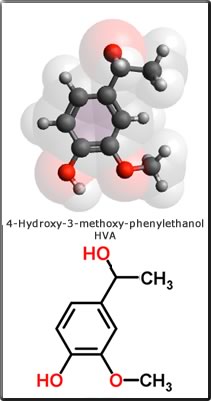
-9-Hydroxy-2-decenoic acid-2.jpg)
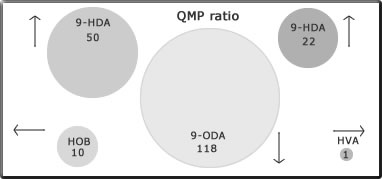
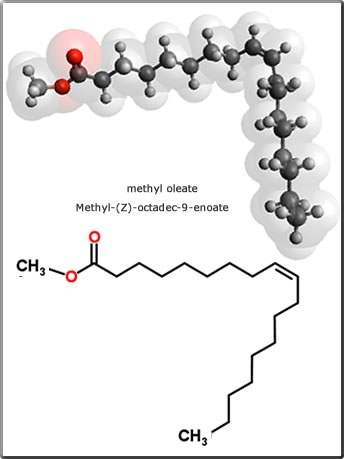
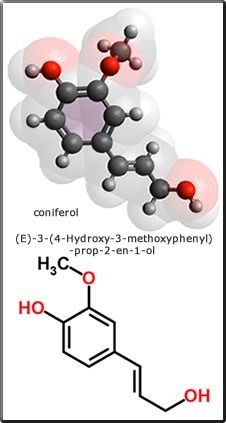
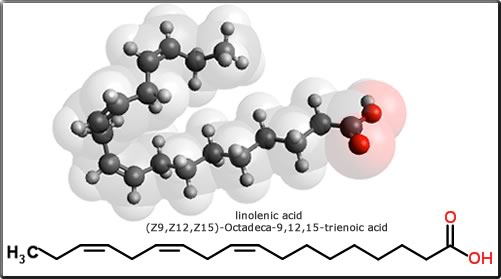
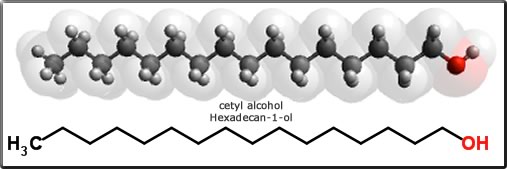
9-ODA has long been known to be a long distance sex pheromone which the queen uses on her mating flights. The other components of the QMP are thought to play a role in the communication between sexes but not act as sex pheromones.
When the virgin queen leaves her colony for her mating flight, drones detect 9-ODA and start searching and chasing the queen with only the fastest being successful.
When the virgin queen leaves her colony for her mating flight, drones detect 9-ODA and start searching and chasing the queen with only the fastest being successful.
Pheromones used in the interaction of the Queen and Drones
Pheromones used in the interaction between Workers
-11-icosen-1-ol.jpg)
Pheromones used in the interaction between Workers and Brood
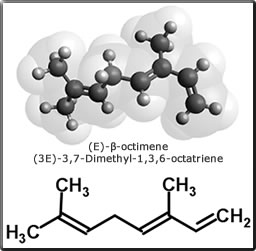
Brood pheromone (BP) is found on the surface of the bee larvae. It is a blend of 10 fatty acid esters:
(methyl palmitate, methyl oleate, methyl stearate, methyl linoleate, methyl linolenate, ethyl palmitate, ethyl oleate, ethyl stearate, ethyl linoleate and ethyl linolenate).
Some components are more active than others, but all 10 individual compounds show some releaser pheromone effect on adult bees. The esters are present in different amounts and proportions as a function of caste and larval age. Thus, nurse bees can recognize the various needs of the larvae and provide them with optimal care.
Four esters, methyl linolenate, methyl linoleate, methyl oleate, and methyl palmitate, induce the worker bees to cap the cell with a thin cover of wax. They are produced in large quantities by the larvae during the capping stage.
BP was tested as an additional chemical stimulus in the artificial rearing of queens. It was found that:
methyl stearate increases the acceptance of the queen cells,
methyl linoleate enhances the amount of royal jelly deposited by the worker, and
methyl palmitate increases the weight of the larvae.
These 10 esters which make up BP are non-volatile are passed from worker to worker by contact. They inhibit ovary development.
(Information sourced from Le Conte et al. published 1990, 1994, 1995, 2001, 2006)
(methyl palmitate, methyl oleate, methyl stearate, methyl linoleate, methyl linolenate, ethyl palmitate, ethyl oleate, ethyl stearate, ethyl linoleate and ethyl linolenate).
Some components are more active than others, but all 10 individual compounds show some releaser pheromone effect on adult bees. The esters are present in different amounts and proportions as a function of caste and larval age. Thus, nurse bees can recognize the various needs of the larvae and provide them with optimal care.
Four esters, methyl linolenate, methyl linoleate, methyl oleate, and methyl palmitate, induce the worker bees to cap the cell with a thin cover of wax. They are produced in large quantities by the larvae during the capping stage.
BP was tested as an additional chemical stimulus in the artificial rearing of queens. It was found that:
methyl stearate increases the acceptance of the queen cells,
methyl linoleate enhances the amount of royal jelly deposited by the worker, and
methyl palmitate increases the weight of the larvae.
These 10 esters which make up BP are non-volatile are passed from worker to worker by contact. They inhibit ovary development.
(Information sourced from Le Conte et al. published 1990, 1994, 1995, 2001, 2006)
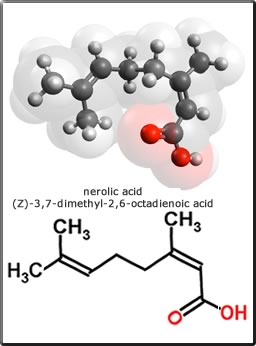
E-β-ocimene is another pheromone emitted by very young larvae. It is highly volatile and so easily dispersed throughout the colony. The blend of the 10 esters mentioned above and E-β-ocimene control the development of the brood and the behaviour of the nurse bees.
Very young brood which have a low need for nurse bees produce a low concentrations of the brood ester pheromone. This promotes an increases in the development of the nurse bee into more mature workers which are not involved in brood care( i.e. nectar processing) in the brood nest.
However, very young brood produce a high concentration of E-β-ocimene, which slows down the maturation of young bees so keeping these in contact with the young brood.
More mature brood produces higher concentrations of the 10 ester BP at the capping stage.
Very young brood which have a low need for nurse bees produce a low concentrations of the brood ester pheromone. This promotes an increases in the development of the nurse bee into more mature workers which are not involved in brood care( i.e. nectar processing) in the brood nest.
However, very young brood produce a high concentration of E-β-ocimene, which slows down the maturation of young bees so keeping these in contact with the young brood.
More mature brood produces higher concentrations of the 10 ester BP at the capping stage.

